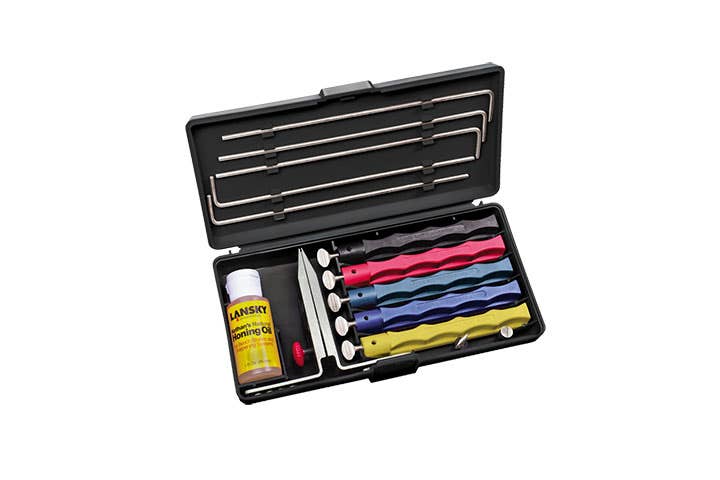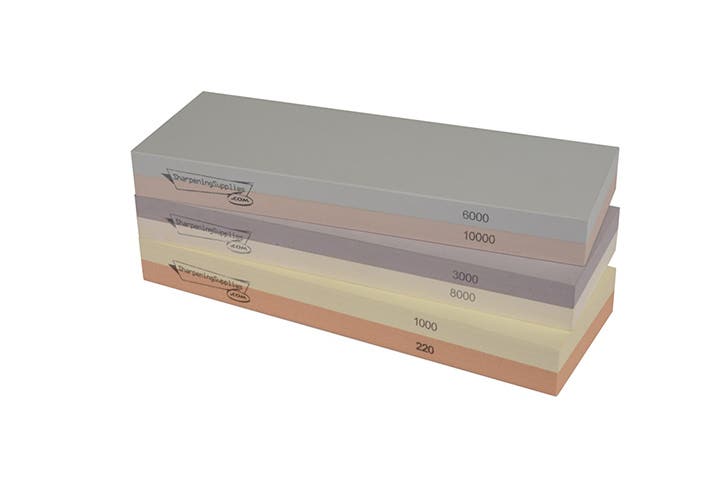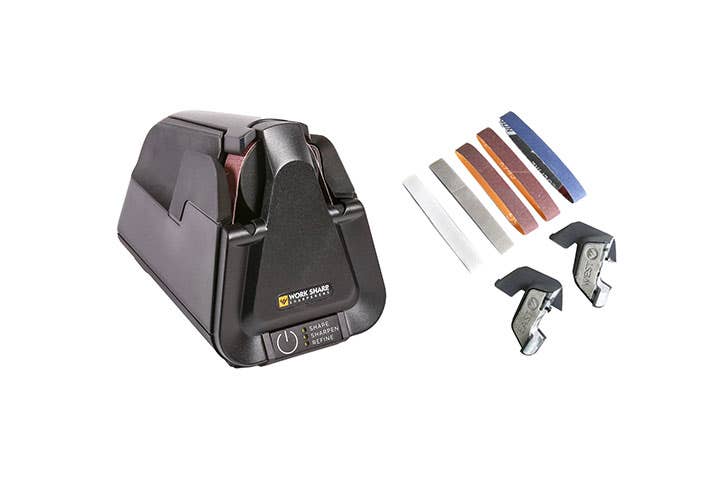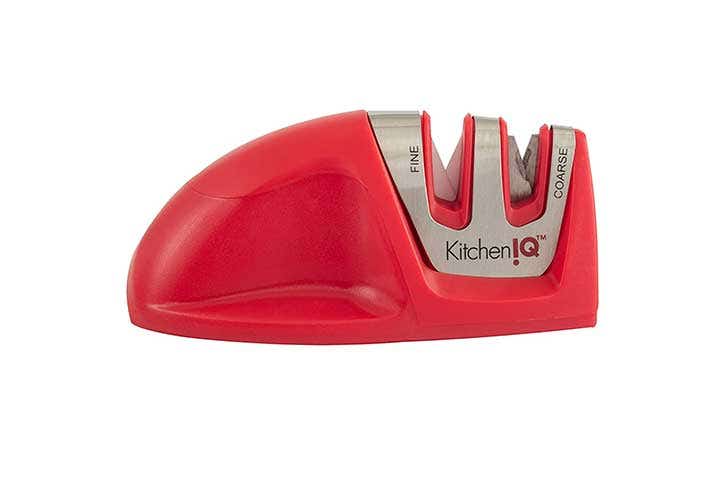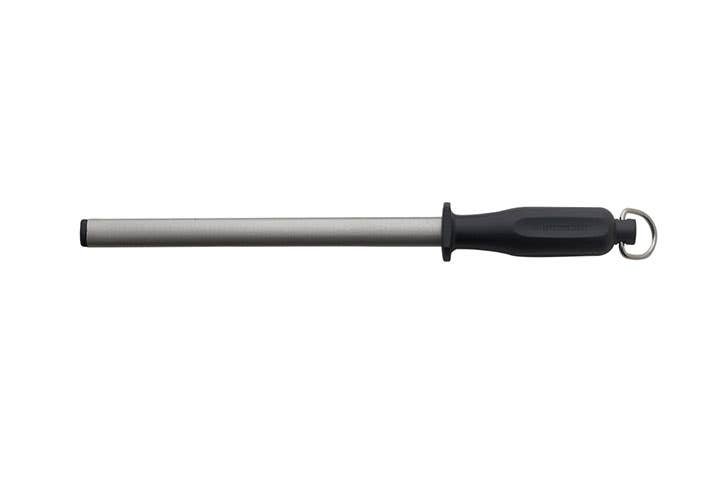A Cut Above The Rest: The Best Knife Sharpeners for All Types of Cooks
Whether you want perfection, convenience, or a deal, there’s a sharpener for you.
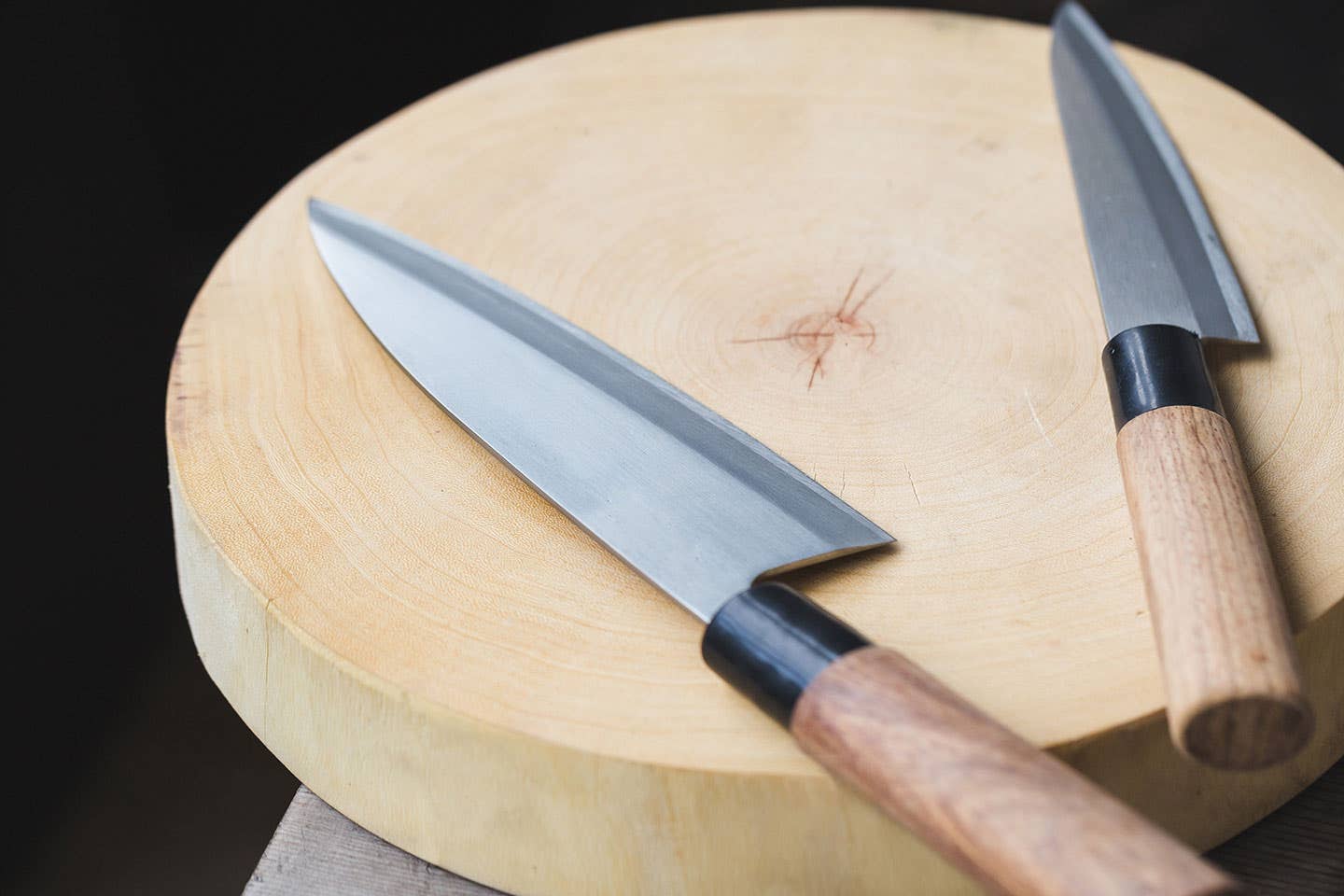
That moment when you’re slicing a tomato for a sandwich and realize it's being bludgeoned into a juicy, pulpy mess, followed by the realization that you can't even remember that last time you sharpened your knives. If you need those blades sharpened in a hurry, a home sharpener is a great solution—but a quick Google search turns up a dizzying variety of types of knife sharpeners and an even greater variety of prices and materials, not to mention bizarre and specific jargon. Who knew figuring out what kind of knife sharpener to get could be such a confounding task? How do you pick the best one when they range from $5 to $500?
Ultimately, which knife sharpener is right for you comes down to how you prioritize three things: precise results, ease of use, and price. There's an old saying that contractors quote for projects: "You can have it fast, good, or cheap—pick two." Picking a knife sharpener is similar: if you’re looking for a cheap, quick fix that gets you back to chopping as soon as possible, the “best” sharpener is going to be different than if you have invested time and money in researching and purchasing a top-tier knife that will last a lifetime. Of the sharpeners we tested, the Lanksy Knife Sharpening System was our favorite, earning high (but not perfect marks) in all three categories, though the finagling required won’t appeal to everyone. While no knife sharpener was Goldilocks-perfect, we identified the best knife sharpeners options for any type of cook.
Our Top Picks
- Best Entry-Level Pro: Lansky Deluxe 5-Stone Knife Sharpening System
- Best for Premium Knives: Sharpening Supplies Double-Sided 8" XL Water Stones
- Best Electric: WorkSharp Professional Electric Kitchen Knife Sharpener + Upgrade Kit
- Best Value: Kitchen IQ 2-Stage Knife Sharpener
- Best for Maintenance: Messermeister Diamond Oval Sharpening Rod
Best Entry-Level Pro: Lansky Deluxe 5-Stone Knife Sharpening System
Best Entry-Level Pro
Ease of Use: Medium | Precision: Very High | Price: $62.99
Pros
- Easy to use
- Accommodates a variety of standard angles
- System packs neatly into a small case
- Moderately-priced
Cons
- Setup not intuitive
- Only sharpens to 17 degrees which not ideal for single-bevel or very fine Japanese knives
Why we chose it: Jig systems combine the precision of a sharpening stone with the convenience of a fixed angle sharpener. While the initial setup was a bit puzzling, the Lanksy system allows even a first-time sharpener to get a razor-sharp result.
A jig is any tool that controls the location, direction, or motion of parts in a larger tool. In the Lanksy system the knife is clamped into a fixed position. The stones, which are attached to rods that slide through the clamp at various fixed angles, are moved back and forth by hand. Maintaining a proper angle is one of the hardest things to master while learning how to use freehand stones, but the fixed angle system means that you can’t mess up the angle, making it a great option for those who want to get into using stones but might feel a bit intimidated.
The initial setup wasn’t intuitive, but watching a video tutorial was helpful, and the time from starting assembly to sharpening was less than five minutes. The biggest pain point in using this system was keeping the knife in place: overtightening the clamp will scratch your knife, but if it is installed too loosely the knife slides around. (In user forums online, one common trick for countering this is to place a small piece of electrical tape between the clamp and the blade.)
Given the huge range of options and considerations in sharpeners, we didn’t choose a “Best Overall” sharpener for this story, but the Lanksy came close. The dummy-proof fixed angles brought the very first knife we sharpened (a dull and chipped $10 filet knife) back to razor sharpness in 15 minutes. And at half the price of other premium sharpeners, this is a great entry point for anyone who wants to get serious about caring for their knives.
Note: We chose the Lanksy Deluxe System over its sibling products because we liked the inclusion of higher grit stones to get an extremely polished edge, though the Universal System would be good for those wanting to sharpen serrated knives, the Standard System would be fine if you wanted to save a few bucks.
Best for Premium Knives: Sharpening Supplies Double-Sided 8" XL Water Stones
Best for Premium Knives
Ease of Use: Very Hard | Precision: Very High | Price: (220/1000 Stone) $44.99; (3000/8000 Stone) $71.99
Pros
- Superior Precision
- Affordable
- Good margin of error
- Stones last a lifetime if properly cared for
Cons
- Steep learning curve
- Stones require at least 10-minutes of soaking
Why we chose it: Freehand whetstones are the gold standard among knife enthusiasts and professional chefs due to the superior level of precision they offer to sharpen a knife exactly to your specifications.
Whetstones range from extremely coarse to butter smooth. “The coarser the grit, the faster it sharpens. You use your coarse stones for shaping, and finer stones to get you to a finer edge,” explains John Carmona of SharpeningSupplies.com. To use them, a knife is dragged diagonally against the surface of the knife the desired angle, moving from coarse grits to incrementally finer grits. (Note: while we tested both a 220/1000 stone and a 3000/8000 stone, a beginner would be fine to start with just a 220/1000 stone.) They offer a high level of flexibility and precision, which is particularly important when it comes to the angle of the cutting edge. When we tested knife-sharpening services, nearly all used whetstones in at least one part of their process. If you have invested in high-quality knives that you want to last a lifetime, whetstones are the best option.
Best Electric Sharpener: WorkSharp Professional Electric Kitchen Knife Sharpener & Upgrade Kit
Best Electric
Ease of Use: Very High | Precision: Very High | Price: (Sharpener) $169.96; (Upgrade Kit) $49.95
Pros
- Easy to use
- Fast
- Interchangeable belts and angle guides in upgrade kit allow for highly customizable results
Cons
- Expensive
Why we chose it: If you have premium knives, want excellent sharpening, and don’t mind spending a premium for ease and convenience, the WorkSharp Professional Electric Sharpener is a great choice.
The appeal of electric sharpeners lies in their simplicity. There’s no need to learn a special technique–you turn it on, pull your blade through, et voilà. We tested two WorkSharp electric sharpener models: the E5-NH Professional Electric Kitchen Knife Sharpener (formerly the E5) and the Electric Kitchen Knife Sharpener (formerly the E2). Both models have fixed-angle slots for pulling your blade through and use timers to help prevent over-sharpening. From there the units diverge: the entry-level model has a fixed speed motor and uses spinning disc sharpeners to sharpen to a versatile 20-degree edge, while the professional model has a variable speed motor (one speed for sharpening and another lower speed for refining) and uses interchangeable belts to sharpen to a (more delicate) 17-degree angle.
At more than three times the price of its sibling model, is the professional model really that superior? On its own, no. But the upgrade kit, which is only compatible with the professional model, includes additional belts with a range of grits as well as alternative angle guide modules. To be able to achieve that level of customization at home without having to learn any special technique is remarkable. (If the entry-level model offered any alternative grits in addition to the stock sharpening discs, the competitive price point would make that unit a no-brainer.)
Best In-a-Pinch: Kitchen IQ 2-Stage Knife Sharpener
Best Value
Ease of Use: Very Easy | Precision: Low | Price: $5.99
Pros
- Inexpensive
- Fast
- Easy
Cons
- Fixed angle
- Aggressive, detractive sharpening
- Lackluster results
Why we chose it: Inexpensive handheld carbide- and tungsten-blade sharpeners yield a middling, inconsistent edge but are good to have in a pinch, especially if you want a quick, serviceable result on a knife you aren’t attached to. We chose the KitchenIQ because it is inexpensive and one of the smaller options.
The scene is familiar: you arrive at a vacation house or an AirBnb for a getaway, excited to cook a feast for your loved ones - only to find the knives so dull they are barely usable. Whoever stocked this kitchen hasn’t thought about the condition of the knives in a long time, and any sharpening at all will be a service to you and the next guests. This is a great use case for a pull-through knife sharpener. (I keep a small one in an exterior pocket of my suitcase, right next to the TSA-approved wine key.)
The Kitchen IQ sharpener has two steps: First, the knife is pulled through two pieces of super-hard tungsten carbide forming a V-shape, shaving off metal from either side of the dull edge to create a new one. Then the knife is pulled through two pieces of high grit ceramic, smoothing the edge from the first step. Typically, while they are convenient, inexpensive, and easy to use, these sharpeners yield lackluster results and remove a lot of metal in the process. If you’re sharpening a $10 knife, it’s fine to use a $10 sharpener. But a high-quality sharpener can make any knife sing, and if you have invested in knives that you want to last a long time, a pull-through sharpener is just too detractive and imprecise to be advisable.
Best for Maintenance: Messermeister Diamond Oval 12” Sharpening Rod
Best for Maintenance
Ease of Use: Medium | Precision: High | Price: $34.99
Pros
- Easy to use
- Adds temporary edge
Cons
- Won’t truly sharpen a dull knife
Why we chose it: The sharpening rod won’t bring a dull knife back to life, but this gentle sharpener is a great option if you aren’t inclined to hone your knife before every use. We like the 12-inch model over the 10-inch, as the extra length makes it easier to use.
In the last decade or so, a new category of sharpener has emerged: the sharpening rod. Borrowing the shape and technique of a honing rod, this style of rod is lightly abrasive (the Messermeister uses 800 grit diamond particles), compensating for the reality that few cooks use them every single time they reach for a knife. “When I do hone I use a diamond steel,” Botnick says. “I think it gives the best edge and the shape is easiest to use.”
When you sharpen your knife to razor sharpness, the finest part of the edge is perfectly centered. Then, as you push down on the edge as you chop–surprise, surprise–this microscopic edge begins to bend to one side. The purpose of a honing rod is to gently push that edge back into alignment, without removing steel as you would with proper sharpening. This is widely accepted as a crucial part of knife maintenance–except few people actually do religiously. As Molly Botnick, Executive Sous Chef at Poppy’s in Brooklyn admits, “I don’t religiously hone, mostly because I think it makes you look like kind of a jerk. But I should.”
How We Chose These Products
We selected these products to represent the full spectrum of types of knife sharpeners, evaluating them on efficacy, precision, ease of use, and cost. Given the huge range of materials, prices, and styles of sharpeners, we ultimately decided there was no single best “overall” option, instead focusing on the advantages and disadvantages of different types of sharpeners for different types of cooks, consumers, and their knives.
Features to Keep in Mind
Ease of Use
Some sharpeners are totally foolproof (pull-through sharpeners), and some sharpeners are more versatile than others–stones, jigs, and some electric sharpeners can be used to sharpen things like serrated knives, garden tools, or scissors.
Ultimately once you’ve mastered the technique, any should do the trick in under 10 minutes
Some sharpeners—specifically whetstones—require a bit of practice before becoming fully useful. Vincent Lau is the head sharpener at Korin in New York City and apprenticed under a Japanese master to hone his craft. Prior to the pandemic, he taught sharpening workshops on whetstones at Korin. “Everyone would leave with a sharper knife,” he explained “but few would have an extremely sharp knife.” Because the whetstone technique is freehand, the user fully controls the angle, pressure, and direction of the knife on the stone—a lot for a novice to learn.
The good news is you’re very unlikely to ruin your knife using whetstones, as they are one of the gentler forms of sharpening. “I recommend buying a whetstone, watching some YouTube, and playing around with it,” advises Botnick. “You may make it duller at first, but try, try, and try again.”
Manual vs. Electric Knife Sharpeners
Regardless of whether you’re using a pull-through sharpener or some sort of stone, manual sharpeners (and therefore the humans that operate them) are inherently slower than electric sharpeners. While this means that the process will always take longer, it also means that there is a smaller margin of error, as it’s harder to do anything that could seriously damage your knives in slow motion.
Abrasive Material and Grit
At its simplest, knife sharpening is using a harder material (your sharpener) to abrade a softer one (your knife). That’s the easy part. From there, there is a huge sea of features to dive into, including abrasive materials (both natural and manufactured), the forms they come in (suspended, vitrified, fused, shaped into blades, etc.), and the knife itself (different types of metal have different levels of hardness, influencing how easily or quickly it can be abraded).
Size
Some knife sharpeners are palm-sized and made of lightweight plastic and a couple of carbide blades, others are breadloaf-sized machines with hefty motors. How much you prioritize portability will influence what option makes sense for you.
Ask the Experts
Q: How long do knife sharpeners last?
With proper care and maintenance, most sharpeners can last a very long time–10 years or more. Over time, whetstones will “dish” and need to be flattened with a flattening stone, while abrasive belts and discs will wear out and need to be replaced; even some inexpensive pull-through sharpener brands offer replacement blades. And while the individual components may need replacing, they are inexpensive–generally $15 or less.
Q: When it comes to knife sharpeners, what do coarse and fine mean?
These terms refer to the level of intensity of the abrasive in a sharpener, as well as the characteristics of the grit. “Coarse grit” is literally that: larger abrasive particles that sharpen more aggressively, while “fine grit” means there are smaller particles. The numbers that are used to describe grits are a rating system (not a unit of measurement!) and can be more helpful, as “coarse” and “fine” may vary from manufacturer to manufacturer.
Q: Can a knife sharpener sharpen scissors?
Yes! Though it depends on the sharpener. The whetstones and both of the electric sharpeners reviewed in this article can all be used to sharpen scissors.
Q: How does knife sharpening work?
A brand new knife’s edge is a straight line of tiny particles of steel. With use, this edge gets bent, dulled, and nicked, moving the particles from a sharp straight line to a rounded, bent one. Sharpening happens in two ways: one, removing metal from the outside of the rounded edge to bring out a sharp point; two, pushing the existing particles back into alignment (honing). Depending on the sharpener, one or both of these techniques may be used.
Our Take
A dull knife is a drag—sometimes literally. Finding the right knife sharpener requires a bit of introspection: what’s most important to you as a cook? If a knife that’s sharp enough to shave the hair off your forearm is a priority, whetstones are the way to go. If you want to get back in the chopping game as soon as possible, a pull-through sharpener is for you (whether that be manual or electric). At the end of the day, the best knife sharpener is the one that fits you, your schedule, and your wallet.
Keep Reading
Continue to Next Story
